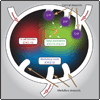Tug of war at the exit door
- PMID: 18199414
- PMCID: PMC2719829
- DOI: 10.1016/j.immuni.2008.01.001
Tug of war at the exit door
Abstract
The lipid sphingosine-1-phosphate has been identified as a key exit signal for lymph nodes. In this issue of Immunity, Pham et al. (2008) show that its action can only be understood in the context of retention signals transduced by CCR7.
Figures

Comment on
-
S1P1 receptor signaling overrides retention mediated by G alpha i-coupled receptors to promote T cell egress.Immunity. 2008 Jan;28(1):122-33. doi: 10.1016/j.immuni.2007.11.017. Epub 2007 Dec 27. Immunity. 2008. PMID: 18164221 Free PMC article.
References
-
- Chakraborty AK, Dustin ML, Shaw AS. In silico models for cellular and molecular immunology: successes, promises and challenges. Nat Immunol. 2003;4:933–936. - PubMed
-
- Dustin ML. Stop and go traffic to tune T cell responses. Immunity. 2004;21:305–314. - PubMed
-
- Mandala S, Hajdu R, Bergstrom J, Quackenbush E, Xie J, Milligan J, Thornton R, Shei GJ, Card D, Keohane C, et al. Alteration of lymphocyte trafficking by sphingosine-1-phosphate receptor agonists. Science. 2002;296:346–349. - PubMed
-
- Okada T, Cyster JG. CC chemokine receptor 7 contributes to Gi-dependent T cell motility in the lymph node. J Immunol. 2007;178:2973–2978. - PubMed
Publication types
MeSH terms
Substances
Grants and funding
LinkOut - more resources
Full Text Sources

